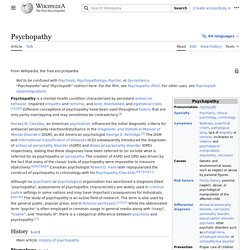

Evil. Philip Zimbardo: The psychology of evil. Psychopathy. Psychopathy, sometimes considered synonymous with sociopathy, is traditionally defined as a personality disorder[1] characterized by persistent antisocial behavior, impaired empathy and remorse, and bold, disinhibited, egotistical traits.

Different conceptions of psychopathy have been used throughout history. These conceptions are only partly overlapping and may sometimes be contradictory.[2] Hervey M. Cleckley, an American psychiatrist, influenced the initial diagnostic criteria for antisocial personality reaction/disturbance in the Diagnostic and Statistical Manual of Mental Disorders (DSM), as did American psychologist George E. Partridge.[3] The DSM and International Classification of Diseases (ICD) subsequently introduced the diagnoses of antisocial personality disorder (ASPD) and dissocial personality disorder respectively, stating that these diagnoses have been referred to (or include what is referred to) as psychopathy or sociopathy.
Definition[edit] Conceptions[edit] CNS - 'Slenderman' Stabber Breaks Down in Court. WAUKESHA, Wis.

(CN) — For the first time since she was charged with the near-fatal stabbing of her middle-school classmate, Morgan Geyser cried in court Friday as the judge denied her request to live under house arrest while awaiting trial. Waukesha County Circuit Court Judge Michael Bohren was no more merciful with Geyser's co-defendant, Anissa Weier, who admittedly collaborated with Geyser in the May 2014 stabbing of their school friend at a forest near her house. Payton Leutner survived the attack after a bicyclist found her crawling from the forest with 19 stab wounds.
All the girls were 12 at the time of the attempted murder, as it has been charged. The assailants have claimed they did it to please Slenderman, a fictional internet boogeyman they believed they could live with if they completed the murder. August Natterer Meine Augen zur Zeit der Erscheinungen. Schizophrenia. Schizophrenia (/ˌskɪtsɵˈfrɛniə/ or /ˌskɪtsɵˈfriːniə/) is a mental disorder often characterized by abnormal social behavior and failure to recognize what is real.

Common symptoms include false beliefs, unclear or confused thinking, auditory hallucinations, reduced social engagement and emotional expression, and lack of motivation. Diagnosis is based on observed behavior and the person's reported experiences. Genetics and early environment, as well as psychological and social processes, appear to be important contributory factors. Some recreational and prescription drugs appear to cause or worsen symptoms. The many possible combinations of symptoms have triggered debate about whether the diagnosis represents a single disorder or a number of separate syndromes. Symptoms Self-portrait of a person with schizophrenia, representing that individual's perception of the distorted experience of reality in the disorder Positive and negative Onset Causes Genetic Environment Substance use Mechanisms Diagnosis. Schizophrenia. Definition Schizophrenia is a chronic and severe mental disorder that affects how a person thinks, feels, and behaves.

People with schizophrenia may seem like they have lost touch with reality. Although schizophrenia is not as common as other mental disorders, the symptoms can be very disabling. Signs and Symptoms Symptoms of schizophrenia usually start between ages 16 and 30. The symptoms of schizophrenia fall into three categories: positive, negative, and cognitive. Positive symptoms: “Positive” symptoms are psychotic behaviors not generally seen in healthy people. HallucinationsDelusionsThought disorders (unusual or dysfunctional ways of thinking)Movement disorders (agitated body movements) Negative symptoms: “Negative” symptoms are associated with disruptions to normal emotions and behaviors. “Flat affect” (reduced expression of emotions via facial expression or voice tone)Reduced feelings of pleasure in everyday lifeDifficulty beginning and sustaining activitiesReduced speaking. August Natterer.
August Natterer (1868–1933), also known as Neter, was a schizophrenic German outsider artist.

Hexenkopf (The Witch's Head), ca. 1915 Biography[edit] August Natterer, given the pseudonym Neter by his psychiatrist to protect him and his family from the immense social stigma associated with mental illness at the time, was born in 1868 in Schornreute near Ravensburg, Germany, the son of a clerk and the youngest of nine children. Natterer studied engineering, got married, travelled widely, and had a successful career as an electrician but was suddenly stricken with delusions and anxiety attacks.[1] On April Fool's Day 1907 he had a pivotal hallucination of the Last Judgment during which "10,000 images flashed by in half an hour. I saw a white spot in the clouds absolutely close – all the clouds paused – then the white spot departed and stood all the time like a board in the sky. Artistic works[edit] Max Ernst's Oedipus was influenced by Natterer's piece Miraculous Shepherd.[6] References[edit]
Teen Slender Man Stabber Claims Sexual Abuse in Hospital, Denied House Arrest. Last week, a Wisconsin judge denied the teenage girls involved in the so-called "Slender Man stabbing" their request to live under house arrest.

The girls were hoping to return home while awaiting trial, but instead both will stay in custody, their bail set at $500,000 each. Thirteen-year-old Morgan Geyser and 14-year-old Anissa Weier were arrested in May 2014 after reportedly stabbing their friend, Payton Leutner, 19 times. Leutner survived. Geyser and Weier said they were acting under the orders of Slender Man, a fictional Internet character who they claim told them to murder Leutner. According to police, the stabbing occurred after a sleepover on Saturday, May 30, 2014; in the morning, the three girls went to a nearby park, where Geyser and Weier lured Leutner into the woods.
"Once there, one suspect held the victim down while the other suspect stabbed her 19 times," Police Chief Russell Jack said in a press conference. Geyser openly wept at the judge's decision.